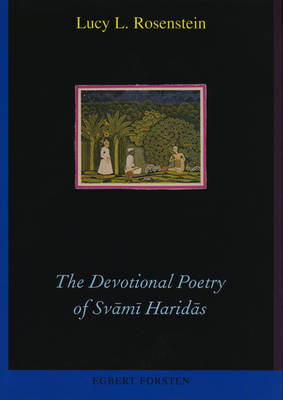
- Afhalen na 1 uur in een winkel met voorraad
- Gratis thuislevering in België vanaf € 30
- Ruim aanbod met 7 miljoen producten
- Afhalen na 1 uur in een winkel met voorraad
- Gratis thuislevering in België vanaf € 30
- Ruim aanbod met 7 miljoen producten
Zoeken
€ 128,45
+ 256 punten
Omschrijving
The 16th-century North Indian religious devotee, poet and musician, Svāmī Haridās, composed lyrics in Braj Bhāṣā, dedicated to the divine couple Rādhā and Kṛṣṇa. One hundred twenty-eight of them were later compiled in two anthologies: the didactic Aṣṭādaś siddhānta and the rapturous Kelimāl, and became the theological basis of the Haridāsī sampradāya, a sect which still flourishes in Vrindaban, U.P. Neither of these important works has hitherto been edited, properly translated or studied academically.
The focus of this book is the text of Haridās's poetry: its transmission, edition and interpretation. Sixteen 18th-19th century manuscripts are collated for the edition and classified with the help of computer programmes originally employed in taxonomy. The apparatus criticus is followed by an annotated English translation in which readings are assessed and points of linguistic interest discussed. The language of Haridās's text is thoroughly examined, and a comprehensive etymological glossary is included to enhance our knowledge of Braj.
Going beyond textual criticism, the book sets Haridās's verses in a broader context. The introductory chapter discusses the theological views of the Haridāsī tradition against the background of bhakti, analyses the sources of information about Haridās, and attempts to reconstruct his life. Since Haridās's lyrics were composed to be sung some of their musical features are analysed. The text of the Kelimāl is also examined through the sectarian concerns of its main commentaries. This study will be an important source of information to all scholars of Braj language and Kṛṣṇa devotionalism.
The focus of this book is the text of Haridās's poetry: its transmission, edition and interpretation. Sixteen 18th-19th century manuscripts are collated for the edition and classified with the help of computer programmes originally employed in taxonomy. The apparatus criticus is followed by an annotated English translation in which readings are assessed and points of linguistic interest discussed. The language of Haridās's text is thoroughly examined, and a comprehensive etymological glossary is included to enhance our knowledge of Braj.
Going beyond textual criticism, the book sets Haridās's verses in a broader context. The introductory chapter discusses the theological views of the Haridāsī tradition against the background of bhakti, analyses the sources of information about Haridās, and attempts to reconstruct his life. Since Haridās's lyrics were composed to be sung some of their musical features are analysed. The text of the Kelimāl is also examined through the sectarian concerns of its main commentaries. This study will be an important source of information to all scholars of Braj language and Kṛṣṇa devotionalism.
Specificaties
Betrokkenen
- Auteur(s):
- Uitgeverij:
Inhoud
- Taal:
- Engels
- Reeks:
- Reeksnummer:
- nr. 12
Eigenschappen
- Productcode (EAN):
- 9789069801025
- Verschijningsdatum:
- 1/01/1997
- Uitvoering:
- Paperback
- Formaat:
- Trade paperback (VS)
- Gewicht:
- 1060 g

Alleen bij Standaard Boekhandel
+ 256 punten op je klantenkaart van Standaard Boekhandel
Beoordelingen
We publiceren alleen reviews die voldoen aan de voorwaarden voor reviews. Bekijk onze voorwaarden voor reviews.








